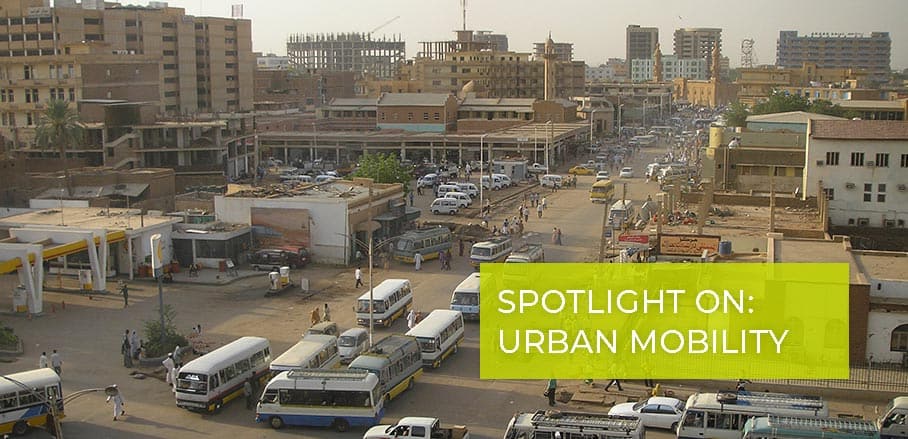Designing Streets for People, not for Cars: The Case of Khartoum
Rapid urbanisation does not have to be a problem as long as we commit to the development of sustainable public spaces. Khalafalla Omer highlights the situation in Khartoum and how urban interventions may improve the future of Sudan’s capital.
In the past, low urban density, efficient street planning and an appropriate transport system made the streets of Khartoum’s downtown area accessible and liveable for all inhabitants. Indeed, the streets were designed as cross-grid pathways to facilitate public mobility in the administrative zone of the city. Cross driveways were allocated for private mobility, while the grid driveways meant to enhance public mobility through a diverse set of public transport means, along with pedestrian-friendly lanes.
Nowadays, however, pedestrians, car drivers, and public transport users in Khartoum city are struggling with poor street conditions. Public streets became an increasing source of air, waste, storm water, and light pollution due to the rapid growth of fuel-based vehicles, inappropriate street levelling, an absent storm water drainage system and irregular urban design for side buildings. This in turn harms the health of city residents significantly, while also affecting their mobility.
After all, recent statistics prove that fuel-based vehicles produce 75 per cent of carbon monoxide pollution and 27 per cent of greenhouse gas emissions which can cause chronic pulmonary diseases and lung cancer. Estimates also show that traffic on irregular and non-pedestrian friendly streets not only increases travel time by 50 per cent, but also reduces economic productivity by 20 per cent, while doubling the rate of traffic accidents.
Making Walkability and Public Transport Top Priorities
As a result, Khartoum needs to urgently enhance public mobility – and what stands in the way is not, as often believed, rapid unplanned urbanisation. Between 1955 and 2010, Khartoum’s population grew from 250.000 to 7 million, with a simultaneously rising number of vehicles. Yet, urban density has decreased, proving that urbanisation as such may not be the main issue here.
The culprit seems to be the apparent lack of sustainable public street plans that accommodate new varieties of urban mobility. Thus, this situation calls for a policy shift towards safe, eco-friendly and sustainable strategies that prioritise the efficiency of walkability and public mobility.
Indeed, there are many reasons why walkability and public transport planning should become top priorities for the local government in Khartoum. First of all, public transport and walkable lanes have much higher capacities for social mobility than private car lanes, being able to transport 25.000 and 9.000 people per hour, respectively. Private care lanes only have the capacity to transport 1.600 people per hour. Secondly, the frequency of trips through walking and public transport is significantly on the rise, and Khartoum must address this demand accordingly. For instance, over 75 per cent of school trips and 50 per cent of trips to local markets, health care centres or social visits are on foot.
Last but not least, the rising number of traffic accidents requires an urgent shift in Khartoum’s urban layout. About 70 per cent of traffic accident victims are pedestrians after all, while 60 per cent of traffic impactors are public transports vehicles. Currently, the streets of the city show no paved sidewalks and there is a lack of designated lanes and space for public transport. This emphasises the need for urban planning mechanisms that primarily address the needs of pedestrians and public transport users.
Turning Streets into Sustainable Public Spaces – Quick Tips
Evidently, we need interventions of tactical urbanism that tackle the complicated challenges Khartoum faces – and in times of scarce financial resources, it seems even more important to make use of the many opportunities that are already available. The overall goal should be to create green, safe and accessible public streets that promote the city’s liveability and ensure an appropriate development viability. To that end, in the following you can find a list of quick tips and recommendations that are not only applicable to Khartoum, but can be used for public street planning in any urban setting:
Promote Public Street Liveability:
- Prevent visual pollution through vernacular architecture along with signboard arrangements.
- Enhance socio-economic activities by regulating the commercial use of land on side buildings of main streets while creating better workplaces for street vendors.
- Create standards for street architecture utilities to promote safe, clean and accessible streets for all.
- Allocate land for pedestrian-friendly lanes to enhance public mobility.
Enhance Public Transport Accessibility and Mobility:
- Create green-wave traffic flows at street junctions to reduce traffic congestion and travel time.
- Allocate a designated lane for public transport to enhance public mobility.
- Build shaded bus stops to enhance public transport accessibility and advocate for the use of public transport.
- Transfer narrow congested streets into one-way streets to enhance transport mobility.
- Create appropriate intersection visibility between vehicles at street junctions.
Create Eco-friendly Mobility Systems:
- Promote the use of eco-friendly vehicles through controlling the process of vehicle imports and vehicle license renewal.
- Create flood zone maps while maintaining appropriate levelling of streets to prevent the impact of flood and heavy rain in autumn season.
- Create green street systems to observe storm water while enhancing street landscaping.
- Use of shading, climate-resilient trees to protect pedestrians from direct sun light.
- Use of solar light poles to reduce energy consumption.
Participatory Planning:
In order to develop well-structured, needs-based and inclusive objectives, various urban stakeholders have to be included in the process from the beginning on, such as the ministry of planning, environment councils, local governments, consultancy firms, transportation authorities, ministry of finance, land authorities, along with district residents, retail and side building owners.
- Designing Streets for People, not for Cars: The Case of Khartoum - 12. May 2020
- Khartoum: Urban Chaos and the Reclaiming of City Character - 13. February 2020
- Urban Regeneration After Catastrophe: The Fire at Omdurman Market - 29. January 2019
